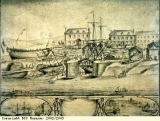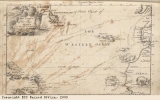Changes in trade
In the late 18th century fewer slaving voyages were leaving Bristol each year. There may have been several reasons for this. One of these would have been war. War always affected trade. The American War of Independence in 1776 and a war with France in 1793 meant that shipping was at risk from attack by privateers and enemy naval ships. Privateers were licensed pirates. The ship’s owners bought the right from the government to take enemy ships and share the profits of the sale of the ship and cargo. At time of war, merchant ships often sailed in convoy (several ships together) with a privateer or Royal Navy ships to protect them. This image shows a privateer, the Caesar, beating off a French ship that attacked a convoy of ships sailing from Jamaica in the Caribbean. The Caesar was there to protect the other ships.
By the late 18th century, fewer merchants were involved in the slave trade. Many of the older leading merchant families had withdrawn from the trade. Instead the leading slave traders after 1780, John Anderson, James Rogers and James and Thomas Jones, were relative newcomers. The level of financial investment in the slave trade remained high, but the risk was carried by a small number of investors. It is not clear why Bristol’s merchants lost interest in the trade. They may have given up on competing with the port of Liverpool, which had better dock facilities and had become the leading slaving port. Changes in people’s attitudes towards the slave trade may have affected it. The anti-slave trade movement was strong. Were some traders feeling guilty about their involvement in the slave trade? Or did they fear that the movement to end the slave trade was likely to succeed and affect their business?
Another reason for the decline in Bristol’s slave trading activity was the financial collapse of 1793. War with France, famine and a financial collapse threatened many local banks with closure (there were no major banking companies as there are today). At the height of a building frenzy in Bristol, building firms went bankrupt, leaving terraces of unfinished houses in the newly fashionable areas of Clifton, Kingsdown and St Pauls. This economic crisis affected all the city’s merchants. The slave trade went into decline. James Rogers, the city’s leading slave trader, went bankrupt soon afterwards. It was also affected by the repeated threats from the government that they would soon end the slave trade. Some local observers, however, put the decrease in slave trading activity down to the ‘humanity and benevolence’ of the merchants of Bristol who felt that they no longer wanted to be involved in such an inhumane trade.
This slow-down of the transatlantic slave trade meant a change in the trading activities of the merchants in Bristol. They moved away from investing in slaving voyages. Instead they focussed on trading just with Africa or just with the Caribbean. A large number of the voyages from Bristol to Africa in the late 18th century were not involved in buying enslaved Africans. The ships took the usual assortment of trade goods to Africa. However, they used the cloth, brass, guns and so on to buy ivory, palm oil, and tropical woods including camwood and redwood (for making dye), rather than enslaved Africans. The wood, palm oil and ivory would be brought straight back to Bristol and sold. Sidenham Teast, a shipbuilder from the Wapping area in Bristol, was a major investor in these kind of voyages (called ‘bilateral’ voyages). His ships from Africa laden with wood were presumably supplying the shipyard, pictured here, with timber for building ships.
A similar bilateral trade between Bristol and the Americas was also important. Almost all manufactured goods required by those living in the new British-owned colonies of the Caribbean and America, had to be imported. From industrial machinery to building materials, everything needed in the new colonies had to be brought from ‘home’. The colonies had not developed industries which would make them independent of Britain. Indeed, the British government made sure that the colonies should remain dependent on Britain for manufactured goods. This would keep British industry in work. Thanks to this, goods shipped to the Caribbean islands or the American mainland could range from steam-powered machinery for mills to bricks. The American War of Independence in 1776 seriously disrupted this trade, but did not destroy it. The bill shown here is for glass for window panes. They were packed into two crates and shipped to Barbados in the Caribbean. Also pictured here is a chart, which was drawn in the logbook of the slave ship the Lloyd. It shows how ships’ captains used the prevailing winds and currents (the usual direction of the wind and currents in a particular area) to sail their ship by the easiest or shortest route.
By the time that the slave trade was ended in 1807, few Bristol merchants were involved in the trade anymore. The old merchant families had invested their money in other businesses, or in land. Several of the new merchants had gone bankrupt following the financial collapse which happened in 1793. Even though the slave trade had ended, the plantations in the Caribbean and the Americas still had slaves. It was only the actual buying and selling of people that was ended in 1807. Slaves already on plantations remained there and were not freed. The trade going between Bristol and the Americas was therefore still important to the city. Manufactured goods were shipped out to the Caribbean and America, and slave-produced goods came back. These goods fed the city’s developing industries processing the sugar, tobacco, chocolate and cotton from the plantations.






